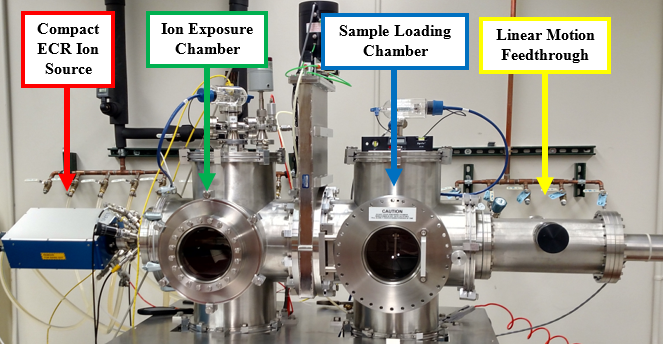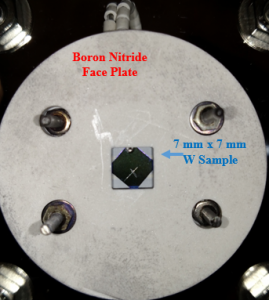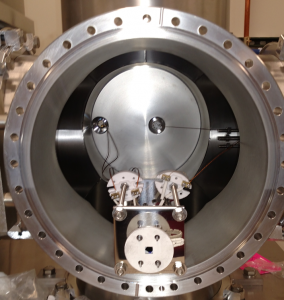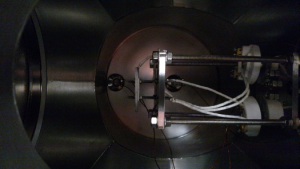The University of Tennessee Nuclear Engineering (UTNE) ion exposure stage utilizes a PCS-ECR Plasma Cracker Source manufactured by SPECS Surface Nano Analysis GmbH, which is a compact electron cyclotron resonance (ECR) ion source (Figure 1). This experiment is similar in design and purpose to the ion exposure stage utilized at Sandia National Laboratory, which demonstrated the capability to produce He bubble growth in heated W samples using a compact ECR ion source.
The UTNE source is capable of operating with helium or other inert gases and is equipped with a molybdenum extraction grid able to be biased up to -1000 V to accelerate the ions to the desired energy. The He ion flux used during these exposures was kept at approximately 2.5e18 ions/m2 sec at the sample face. The W samples are mounted on a pyrolytic boron nitride (PBN) plate heater manufactured by Momentive Performance Materials, which is capable of heating the samples to temperatures up to approximately 1300 K, though the maximum exposure temperature for the samples discussed here was 670 K. The sample is held in place on the heater stage using a boron nitride face plate that also controls the exposed area (Figure 2). The sample holder is mounted on a linear motion vacuum feedthrough in the sample loading chamber.
The sample loading chamber is then able to be sealed and pumped down to several millitorr of pressure in order to allow the gate valve separating the ion exposure chamber and the sample loading chamber to open. The linear motion feedthrough then allows the sample to be inserted into the ion exposure chamber and brought to within 4 cm of the exit aperture of the ion source. The heated samples were exposed for up to six consecutive hours. The higher fluence samples were exposed over several consecutive days.

Figure 1: UTNE ion exposure stage with compact ECR ion source. Samples are loaded in the right chamber (Sample Loading Chamber) and then transferred through a gate valve to the left chamber (Ion Exposure Chamber) for exposure to the ion source using a linear motion feedthrough.

Figure 2: Square W sample (7 mm x 7 mm) mounted on heater stage held in place with BN face plate.

Figure 3: W sample is mounted on heater stage and the assembly is being installed on the linear motion feedthrough in the sample loading chamber.

Figure 4: W sample mounted on heater stage and installed on the linear motion feedthrough inside the sample loading chamber ready for insertion into the ion exposure chamber through the gate valve.